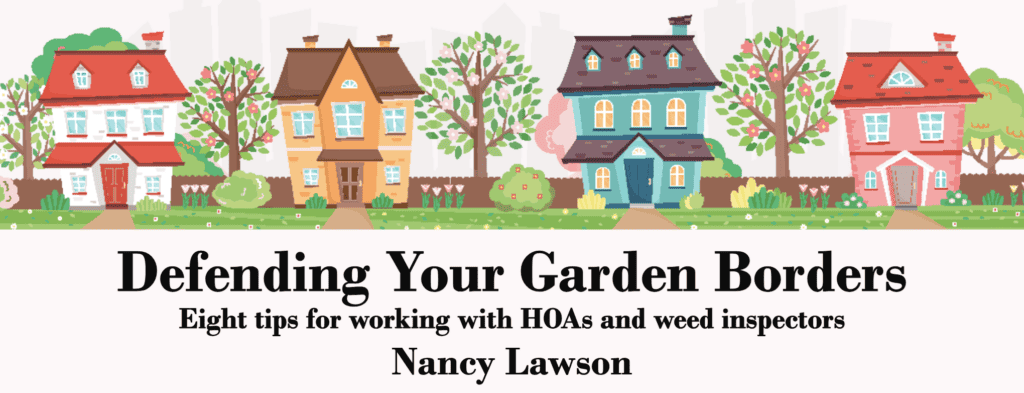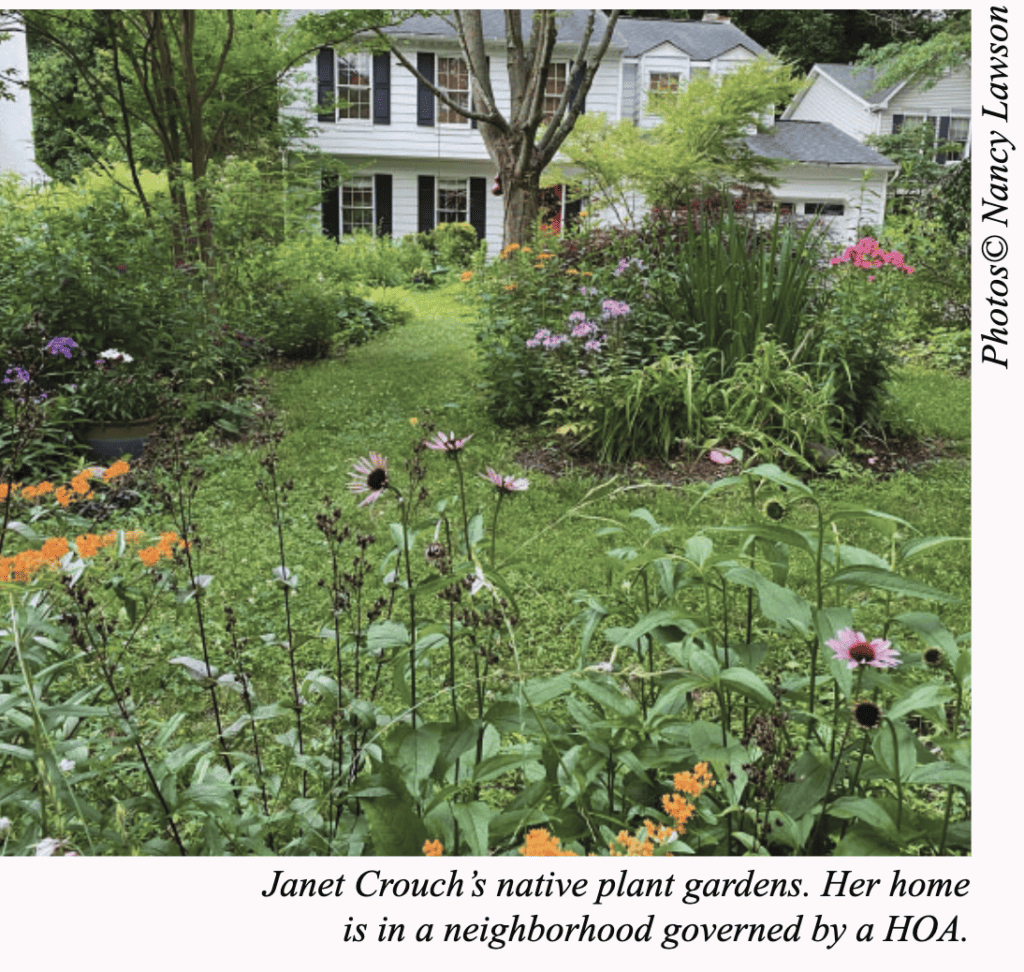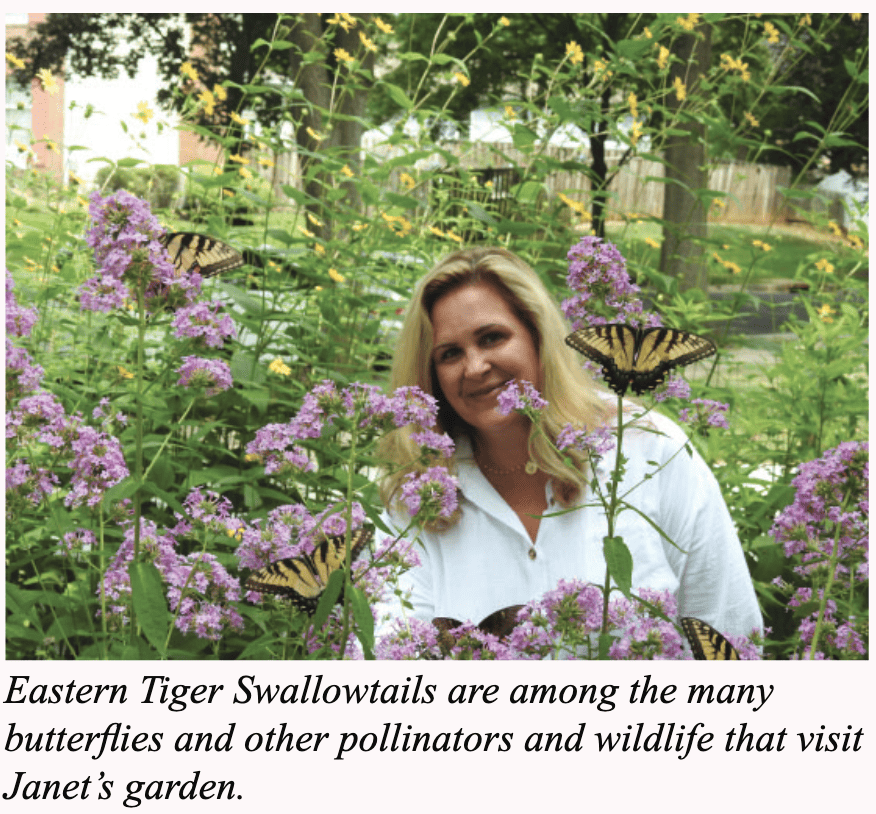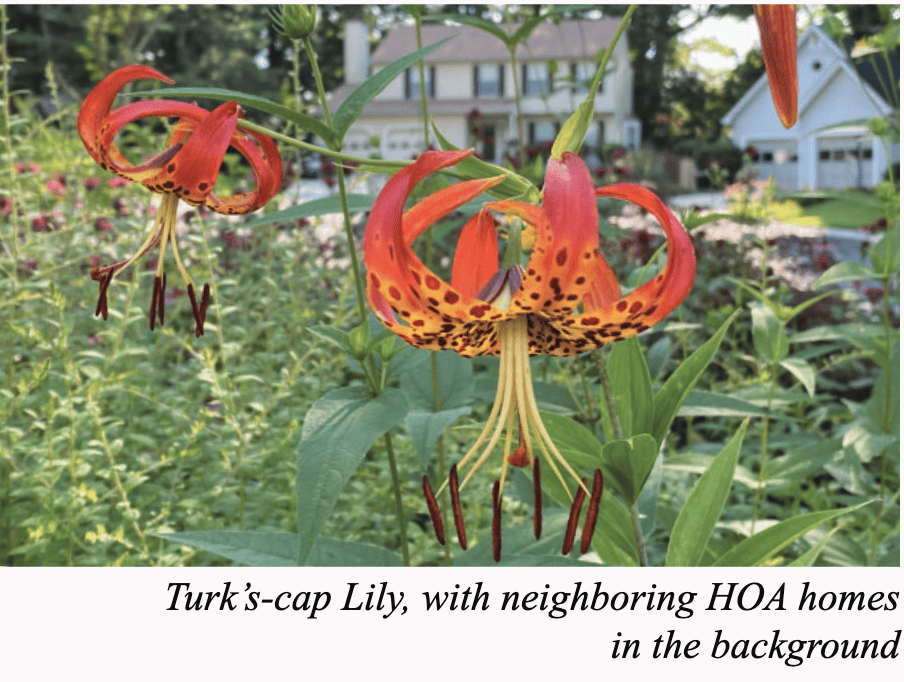8 Tips to Working with HOAs — Defending Your Garden Borders

You’ve caught the bug for “bugs” – and birds and native plants – and are now fully immersed in gardening for wildlife. The bees and butterflies have responded, flying in from points unknown to all their favorite flowers. The birds are flocking to your garden too, pecking at the leaves for insects and snacking on the seedheads. Dragonflies zip about snapping up mosquitoes, and squirrels bury their acorns all over the yard.
But there’s a different kind of animal who isn’t as enamored of your efforts to create a sanctuary for butterflies and other wildlife: the humans so obsessed with lawns that they will stop at nothing to impose them on the entire neighborhood.
If this sounds sadly familiar, it might be comforting to know that you’re not alone. Even in the age of climate change and shrinking habitat, wildlife gardeners around the country routinely face harassment, fines, and citations by Homeowner Association (HOA) boards and municipal agencies that haven’t kept up with the times. My sister, Janet Crouch, was among that group, bullied for years by an overreaching HOA that wanted to replace her butterfly garden with turfgrass. But she fought back, saved her plantings, triggered passage of a state law requiring HOAs to allow wildlife gardens, and inspired legions of other people to stand their ground too.
It’s a frustrating fact that our ability to help wild nature often hinges on the capriciousness of human nature. To change the lifeless-lawn paradigm to benefit butterflies and other wildlife, we need to employ every tool available, as Janet did, to keep the loudest voices from drowning out our efforts. Each situation and community is different, but these general tips can help you navigate the system and make the case for the importance of wildlife habitat in your own back (and front!) yard.

Learn the rules. Before accding to demands to cut down your plants, ask your HOA board or city weed inspectors to cite the exact rules or ordinances they are attempting to enforce. They might try to intimidate you rather than provide straight answers, but remember that you have a right to clear, valid information about relevant laws and homeowner contracts. Many people receive citations for supped violations of architectural guidelines or municipal codes that don’t even exist; in my sister’s case, nothing in the HOA documents prohibited gardens or required approval to plant them.

Lead by example. Gardens of any kind challenge the status quo in turf-dominated communities. Prepare for resistance and lessen the perceived threat of a more dynamic landscape by adding recognizable elements: pathways, birdbaths, outdoor seating, or a row of low-growing, familiar flowers along the front. These cues of intention signal that you are actively managing your property and not simply letting it “run wild”, and can make your habitat more palatable to people unaccustomed to natural plantings. If your community allows signs, post one from the North American Butterfly Association or other environmental group to explain the purpose of your garden to passersby. You could even make your own sign.
Make friends. Neighborhood norms strongly influence landscape choices, so try to launch a domino effect by persuading a friendly neighbor or two to garden more ecologically. Offer free plants and walks through your habitat, and point them to helpful resources when they’re ready to dig in. Ask local experts from watershed associations, ecological landscape design firms, and wildlife organizations to visit; they can meet with your HOA board or speak to your community. Invite weed inspectors to come for a tour, and take the opportunity to name your plants and explain their ecological contributions.
Emphasize financial benefits. If you’re trying to reach decisionmakers unmoved by environmental arguments, focus on cost savings and ecosystem services. In times of extreme weather, plantings that are well-adapted to local climes can help mitigate flooding and survive drought. They don’t require fertilizer and typically don’t need irrigation once established. They eliminate the fossil-fuel use and air and noise pollution associated with endless lawn maintenance. Let your community know about any low-cost and free native plant giveaways offered by local and state agencies, and apply for funding from environmental organizations that award grants for native planting projects.
Bust the myths. Confront outdated tropes about planting for wildlife with factual information: Native plants aren’t “weeds”, even by conventional horticultural standards – they’ve become part of the mainstream and are sold at most nurseries. Wild animals aren’t going to “invade” the neighborhood; they already live among us, and native-plant gardens help keep an ecological balance of predators and prey. Property values will not plummet; if anything, native plant gardens are often considered an asset by real estate professionals. When my sister’s next-door neighbor recently sold her house within days and had multiple offers above list price, visiting agents specifically commented on the beauty of Janet’s garden.

Run for election. Sometimes the only way to understand the decisions of HOA board members is to become one of them. If other board members are reasonable, you can work together to change the system from within. If they’re less progressive, being on the board will at least give you more access to the day-to-day management of the community. When Janet joined her HOA’s board, she discovered that they’d wasted about $100,000 in legal fees to go after her garden.
Spread the word. If you’re having trouble reasoning with decisionmakers, appeal to the community at large. Shine some light on outdated municipal requirements and on less scrupulous HOA operations by reaching out to the media and writing newsletters and emails to your neighbors. They deserve to know when their tax dollars or HOA fees are being spent frivolously.
Get a law passed. When all else fails, appeal to a higher authority. By attending events in our community and telling her story, my sister met influential elected officials with a passion for environmental and social justice. Appalled by her situation, two state delegates introduced a bill to ensure that others wouldn’t have to endure what she had experienced. The legislation, which codifies HOA residents’ right to plant wildlife gardens and prohibits HOAs from requiring turfgrass, passed almost unanimously and was enacted in the fall of 2021.
Gardening for wildlife in a community of monoculture lawns can be lonely, but beyond the entrance to your neighborhood a whole world of people, birds, butterflies, bees, and plants is rooting for your efforts to change the culture – one plant, one garden, and one community at a time.
Editor’s Note – If you live in a community with a Homeowner’s Association, there are probably one or more governance documents that detail what homeowner activities are permissible and how business must be conducted in your community. These are documents taht should be provided to all residents. If you don’t have them, ask your governing body – usually a Board of Trustees – or property manager, if you have one, for a copy. It may be that gardens are perfectly permissible, but depending on their location and your community’s rules, you may need Board approval before planting. Municipal ordinances and state laws are public records that must be made available to anyone who requests them. Try working within the system first. When the system doesn’t permit gardening for wildlife, work to change it.

